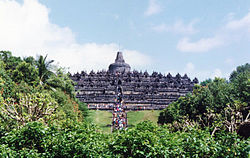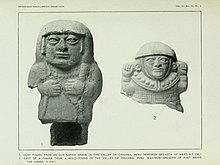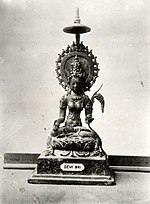
A | B | C | D | E | F | G | H | CH | I | J | K | L | M | N | O | P | Q | R | S | T | U | V | W | X | Y | Z | 0 | 1 | 2 | 3 | 4 | 5 | 6 | 7 | 8 | 9
| Polytheistic Javanism | |
|---|---|
| ꦏꦗꦮꦺꦤ꧀ Kajawèn | |
| Type | Folk religion |
| Governance | National Javanism Religious Council of the Republic Indonesia |
| Region | Central and eastern hemisphere of Java[1][2] |
| Language |
|
| Headquarters | Central Java |
| Recognition | Officially recognized by Indonesian government |
| Separated from | Kapitayan (monotheistic Javanism) |
| Members | Javanese |
| Logo |  |
| Part of a series on |
| Religion of Java |
|---|
 |
| Part of a series on |
| Anthropology of religion |
|---|
 |
| Social and cultural anthropology |
Kejawèn (Javanese: ꦏꦗꦮꦺꦤ꧀, romanized: Kajawèn) or Javanism, also called Kebatinan, Agama Jawa, and Kepercayaan, is a Javanese cultural tradition, consisting of an amalgam of Animistic, Buddhist, Islamic and Hindu aspects. It is rooted in Javanese history and religiosity, syncretizing aspects of different religions and traditions.
Definitions

The term kebatinan is being used interchangeably with kejawèn,[3] Agama Jawa[4] and Kepercayaan,[5][6] although they are not exactly the same:
- Kebatinan: "the science of the inner",[3] "inwardness",[6] derived from the Arabic word batin, meaning "inner" or "hidden".[7]
- Kejawèn: "Javanism",[3][2] the culture and religious beliefs and practices of the Javanese people of Central Java and East Java.[1][2] It is "not a religious category, but refers to an ethic and a style of life that is inspired by Javanist thinking".[8]
- Agama Jawa: "The Javanese religion"[4]
- Kepercayaan: "belief",[5] "faith",[6] full term: Kepercayaan kepada Tuhan Yang Maha Esa,[web 1] "Believer in One Mighty God".[9] "Kepercayaan" is an official cover term for various forms of mysticism in Indonesia. According to Caldarola, it "is not an apt characterization of what the mystical groups have in common".[6] It includes kebatinan, kejiwan and kerohanian.[6]
Kebatinan is the inward cultivation of inner peace, rooted in pre-Islamic traditions,[10] whereas kejawèn is outward and community-oriented, manifesting in rituals and practices.[10]
History
Java has been a melting pot of religions and cultures, which has created a broad range of religious belief, including animism, spirit cults, and cosmology.
Hinduism and Buddhism

Indian influences came firstly in the form of Hinduism, which reached the Indonesian Archipelago as early as the first century.[11] By the fourth century, the kingdom of Kutai in East Kalimantan, Tarumanagara in West Java, and Holing (Kalingga) in Central Java, were among the early Hindu states established in the region. Several notable ancient Indonesian Hindu kingdoms are Mataram, famous for the construction of the majestic Prambanan temple, followed by Kediri and Singhasari. Since then Hinduism, along with Buddhism, spread across the archipelago and reached the peak of its influence in the fourteenth century. The last and largest of the Hindu-Buddhist Javanese empires, that of the Majapahit, influenced the entire Indonesian archipelago.[citation needed]
Hinduism and Buddhism penetrated deeply into all aspects of society, blending with the indigenous tradition and culture.[12] One conduit for this was the ascetics, called "resi," (Sanskrit rishi) who taught a variety of mystical practices. A resi lived surrounded by students, who took care of their master's daily needs. Resi's authorities were merely ceremonial. At the courts, Brahmanas clerics and pudjangga (sacred literati) legitimized rulers and linked Hindu cosmology to their political needs.[12] Presently, small Hindu enclaves are scattered throughout Java, but there is a large Hindu population along the eastern coast nearest Bali, especially around the town of Banyuwangi.
Islam
Java adopted[13][note 1] Islam around 1500 CE.[13] Islam was first accepted by the elites and upper echelons of society, which contributed to its further spread and acceptance. Sufism and other versions of Folk Islam were most easily integrated into the existing folk religion of Java.[13] The learned versions of Sufi Islam and Shari`a-oriented Islam were integrated at the courts, blending with the rituals and myths of the existing Hindu-Buddhist culture.[13] Clifford Geertz described this as abangan and priyayi; "the lower class and elite varieties of Javanese syncretism".[13]
The Kyai, the Muslim scholar of the writ became the new religious elite as Hindu influences receded. Islam recognises no hierarchy of religious leaders nor a formal priesthood, but the Dutch colonial government established an elaborate rank order for the mosque and other Islamic preaching schools. In Javanese pesantren (Islamic schools), The Kyai perpetuated the tradition of the resi. Students around him provided his needs, even peasants around the school.[12]
Christianity
Early 16th century, Christianity was brought to Java by Portuguese traders and missionaries, from the Dutch Reformed Church, and in the 20th century also by Roman Catholics, such as the Jesuits and the Divine Word Missionaries. Nowadays there are Christian communities, mostly Reformed in the larger cities, though some rural areas of south-central Java are strongly Roman Catholic.
Theosophy
Kejawèn is also influenced by Theosophy. Theosophy was a very popular religion among Dutch residents in the Dutch East Indies in the early 20th century. Also, many influential Indonesians joined the Theosophical Society. The Theosophical Society "played a role in the growth" of Kejawèn in the early and mid-twentieth century, and several kebatinan groups were founded by Theosophists. The kebatinan Budi Setia group, founded in 1949, considered "its formal transformation into a theosophical lodge".[14]
Islam and kebatinan
Although Java is predominately Muslim, kejawen the syncretic Javanese culture, still plays a cultural undercurrent among some Javanese.[15]
Some Javanese texts relate stories about Syekh Siti Jenar (also known as Syekh Lemah Abang) who had conflicts with Wali Sanga, the nine Islamic scholars in Java, and the Sultanate of Demak.[16][17]
With the Islamisation of Java there emerged a loosely structured society of religious leadership, revolving around kyais, Islamic experts possessing various degrees of proficiency in pre-Islamic and Islamic lore, belief, and practice.[12] The Kyais are the principal intermediaries between the village masses and the realm of the supernatural. However, this very looseness of Kyai's leadership structure has promoted schism. There were often sharp divisions between orthodox kyais, who merely instructed in Islamic law, with those who taught mysticism and those who sought reformed Islam with modern scientific concepts.
As a result, the Javanese recognize two broad streams of religious commitment:[18][note 2]
- Santri or putihan ("pure ones"), what the majority of Javanese people tend to follow are those who pray, performing the five obligatory daily ritual prayers.[18] They are more orthodox in their Islamic belief and practice,[12] and oppose the abangan, who they consider to be heterodox.[21]
- Abangan, "the red ones", who do not strictly observe the Islamic rituals.[18] They have mixed pre-Islamic animistic and Hindu-Buddhist concepts with a superficial acceptance of Islamic belief,[12] and emphasize the importance of the purity of the inner person, the batin.[18]
This distinction between "the High Islam or scripturalist, shari`a-oriented Islam of the `ulama"[13] and "living local Islam"[13] or "Folk Islam"[13] or "popular Islam"[13] is not restricted to Java but can be found in other Islamic countries as well.[13]
Ernest Gellner has developed an influential model of Muslim society, in which this dichotomy is central:[13]
He sees a dialectical relationship between the two, with periods of scripturalist dominance followed by relapses into emotional, mystical, magical folk Islam. Modernity — especially urbanisation and mass literacy — unsettles the balance between the two, by eroding the social bases of folk Islam. An irreversible shift to scripturalist Islam occurs, which is in Gellner’s view the equivalent of secularisation in the West.[13]
Bruinessen finds this too limited, and distinguishes three overlapping spheres:[13]
- Shari`a-oriented Islam,
- Sufism (mystical Islam, which has its learned and popular variants),
- The periphery of local rituals, local shrines, local spirit cults, and heterodox beliefs and practices in general.[note 3]
Javanese syncretistic religiousness has a strong popular base, outnumbering the santri and the support for Islamic political parties.[22][citation needed] Choy relates this to a Javanese apparent openness to new religions, but filtering out only those elements which fit into the Javanese culture.[23] Choy mentions several reasons for this nominal Islamic identity:[24]
- The Islamic scholars in Java have been trained in curricula that were geared toward social conditions of two or three centuries ago, lacking the ability to impart the spirit and sense of Islam;[23]
- The inability to summarise the principles of Islam in understandable basic points that can be applied to daily life;[24]
- Kebatinan can be learned and understood without the need to learn Arabic.[25]
In the early 20th century, several groups became formalised, developing systematised teachings and rituals, thus offering a 'high' form of abangan religiosity, as an alternative to the 'high' Islam.[26] Bruinessen opines that the kebatinan-movements is a deliberate rejection of scriptural Islam,[27] which arose out of "folk Islam".[13]
Characteristics

Aim
Kebatinan is derived from the Arabic word batin, meaning "inner" or "hidden",[7] or "inner self".[28] It is a metaphysical search for harmony within one's inner self, connection with the universe, and with an Almighty God.[28] Kebatinan believes in a "super-consciousness" that can be contacted through meditation.[25]
Beliefs
Kebatinan is a combination of metaphysics, mysticism, and other esoteric doctrines[28] from Animistic, Hinduistic, Buddhist, and Islamic origins.[citation needed] Although the Javanese culture is tolerant and open to new religions, only those qualities accepted and filtered fit into the Javanese culture, character, and personality.[23] Javanese ideals combine human wisdom (wicaksana), psyche (waskita), and perfection (sempurna). The follower must control their passions, eschewing earthly riches and comforts, so that they may one day reach enlightened harmony and union with the spirit of the universe.
According to Choy, the Kebatinan have no certain prophet,[29] sacred book,[29] nor distinct religious festivals and rituals. Nevertheless, various kebatinan-movements have their foundational writings and founders.[30][26]
A kebatinan practitioner can identify with one of the six officially recognized religions, while still subscribing to the kebatinan belief and way of life.
Membership
Although kebatinan is a predominantly Javanese tradition, it has also attracted practitioners from other ethnic and religious groups, such as Chinese and Buddhists,[31] and foreigners from Australia and Europe.[9] President Suharto counted himself as one of its adherents.[citation needed] Their total membership is difficult to estimate as many of their adherents identify themselves with one of the official religions.[32]
Official recognition
Although Pancasila, Indonesia's national philosophical foundation, recognizes only the "belief in the one and only God"—which is often justified as the sole recognition of monotheism in the country[note 4]—religions not recognized by the government are also tolerated.[15] A broad plurality of religions and sects exist. In the middle of 1956, the Yogyakarta representative of the Department of Religious Affairs reported 63 religious sects in Java other than the official Indonesian religions. Of these, 22 were in West Java, 35 were in Central Java, and 6 in East Java.[12]
These include also kebatinan-groups, such as Sumarah. This loosely organized current of thought and practice was legitimized in the 1945 constitution,[citation needed] but failed to attain official recognition as a religion.[9] In 1973 it was recognized as Kepercayaan kepada Tuhan Yang Maha Esa (Indonesian: Belief in One Mighty God[9][note 5]), but withdrawn from the jurisdiction of the Ministry of Religion and placed under the jurisdiction of the Ministry of Education and Culture.[9]
Practices
| This article is a part of the series on |
| Indonesian mythology and folklore |
|---|
 |
|
|
A variety of practices is being used in kebatinan to acquire ilmu[33][note 6], namely tiraka[34][33][35][note 7] and tapa[34] or tapabrata.[35][note 8]
Many Kebatinan followers practice in their own way to seek spiritual and emotional relief. These practices are not performed in churches or mosques, but at home or in caves or on mountain perches. Meditation in Javanese culture is a search for inner self wisdom and to gain physical strength. This tradition is passed down from generation to generation.[citation needed]
Meditation
There are several tapa:
- tapa Ngalong (meditation by hanging from a tree)
- tapa Kungkum (meditation under a small waterfall or meeting point of 2-3 rivers / Tempuran / Tjampuhan)
Fasting
Fasting is a common practice employed by Javanese spiritualists in order to attain discipline of mind and body to get rid of material and emotional desires:
- pasa Mutih (abstention from eating anything that is salted and sweetened, only eating/drinking pure water & rice)
- pasa Senen-Kemis (fasting on Monday-Thursday)
- pasa Ngebleng (fasting for a longer period, usually 3-5-7 days)
Animistic worship
Zdroj:https://en.wikipedia.org?pojem=KejawènText je dostupný za podmienok Creative Commons Attribution/Share-Alike License 3.0 Unported; prípadne za ďalších podmienok. Podrobnejšie informácie nájdete na stránke Podmienky použitia.
Antropológia
Aplikované vedy
Bibliometria
Dejiny vedy
Encyklopédie
Filozofia vedy
Forenzné vedy
Humanitné vedy
Knižničná veda
Kryogenika
Kryptológia
Kulturológia
Literárna veda
Medzidisciplinárne oblasti
Metódy kvantitatívnej analýzy
Metavedy
Metodika
Text je dostupný za podmienok Creative
Commons Attribution/Share-Alike License 3.0 Unported; prípadne za ďalších
podmienok.
Podrobnejšie informácie nájdete na stránke Podmienky
použitia.
www.astronomia.sk | www.biologia.sk | www.botanika.sk | www.dejiny.sk | www.economy.sk | www.elektrotechnika.sk | www.estetika.sk | www.farmakologia.sk | www.filozofia.sk | Fyzika | www.futurologia.sk | www.genetika.sk | www.chemia.sk | www.lingvistika.sk | www.politologia.sk | www.psychologia.sk | www.sexuologia.sk | www.sociologia.sk | www.veda.sk I www.zoologia.sk
